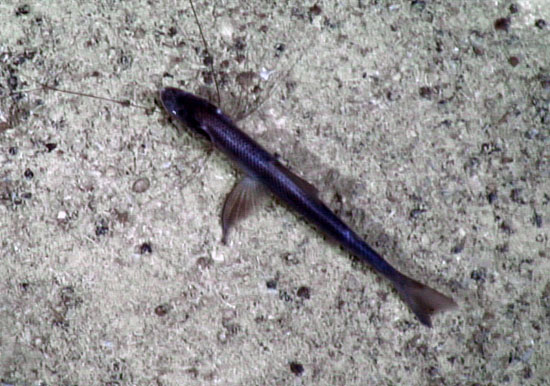Monday 11th February
Overnight and for most of today, Isis dive 199 roamed widely over the seafloor around the Von Damm Vent Field, collecting rock and sediment samples to understand the geology of the area. After 24 hours in the water, the ROV returned the ship in the early evening heaving with rocks.
The Von Damm Vent Field lies on the upper slopes of Mount Dent, which belongs to a type of underwater mountain known as an Oceanic Core Complex. Here at the volcanic rift in the Cayman Trough, the Earth's crust is being pulled apart by inexorable forces, known as tectonic forces, that ultimately result from convection cells in the Earth's mantle. Where the crust is rifting apart, something has to fill the gap created at that rift. Normally magma wells up to do that, and builds new seafloor by erupting lava on the seafloor.
But here in the Cayman Trough, the supply of magma is scarce and sporadic. Sometimes the rift is starved of magma - and yet those inexorable tectonic forces are still pulling it apart. When that happens, a block of crust can get drawn up out of the seabed and pulled over to lie horizontally. Oceanic Core Complexes are those blocks of crust, twisted out of the seabed at rifts starved of magma.
That means is that on the slopes of Oceanic Core Complexes like Mount Dent, we can find rocks exposed on the seafloor that are usually found deep in the Earth's crust and upper mantle, because they have been drawn up out of the seafloor and pulled over to lie horizontally.
So today the ROV was not just travelling over the seafloor - it was actually taking a journey into the Earth's crust and upper mantle, in the sequence of now-exposed rocks that it encountered on the slopes of Mount Dent. It's difficult to collect rocks from that deep in the Earth by drilling straight down, but here Nature has brought them to us. That makes for very happy geologists aboard our ship tonight, and should help us to understand what drives the vents here.

Dive 199 was not all geology: a tripod fish, deep-sea ambush predator, lies in wait for its prey
This morning we managed to achieve a first for the ship: a live video broadcast to an audience in the Attenborough Studio at the Natural History Museum, which was also streamed to an even wider audience over the internet. Adrian Glover from the Natural History Museum talked about our work and life aboard, and took questions from audience members back in London.
I'm very grateful to the ship's IT wizard Mark for his hard work in making the link work, and to the NERC Communications team back home who enabled us to have this facility. We look forward to several similar live links to schools in the coming days.
After offloading the haul of rocks, the Isis ROV team are reconfiguring the vehicle for another dive to investigate the deep-sea animals and vent fluids here, on what will be the 200th dive of the ROV in its career so far.
